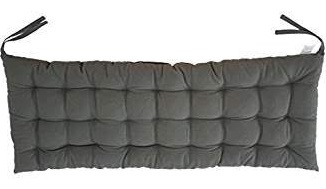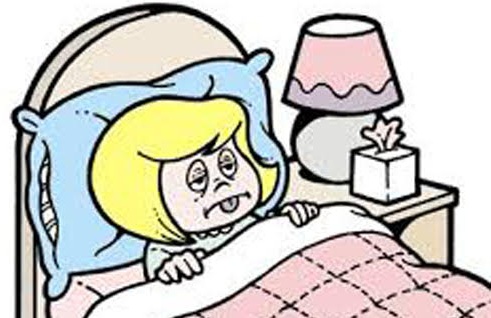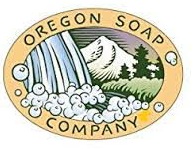
Art | Resources
Chair Pads with Natural Fill

Buy 100% cotton chair and bench pads online.
Question from Stacey
Hi Debra,
I am trying to find affordable chairs for my kitchen table. I have uncomfortable metal chairs now and would like to at least add chair pads. I found some cotton-covered pads, however, the batting is a polyester fill. I cannot find any chair pads with a cotton batting. Would you recommend not using anything with a polyester fill?
Thanks!
Debra’s Answer
I know something about this. I have a metal desk chair and have the same problem.
Before that I had a wood desk chair with the same problem.
Unfortunately you can’t yet go into a store and purchase pillows with natural fill. All they sell is polyester. But online you can get pillows with cotton or wool or kapok fill that are quite comfortable.
I just bought the pillows and then wrapped cotton fabric around them with a design I liked. I didn’t even sew covers.
However, now—and I know this is going to sound funny, but it works—I sit on a folded plush cotton bath rug. It stays in place on the chair better.
You want to look for a “cotton chenille” rug WITHOUT a non-skid backing. Reversable rugs have no backing, just 100% cotton.
You can also just toss them in the washer and wash them and fluff them up in the dryer.
And if you want more plush, just pile them up on your chair until it is “just right.
Now that I said all that, I actually found some seat cushions on amazon with cotton fabric and cotton fill.
Shepherd’s Dream makes an organic wool and cotton Chair Pillow.
White Lotus Home makes their own pillows in many sizes with different organic filling.
And if you don’t find the size you are looking for, the would probably custom make it for you.
So see, there are lots of options.
Consumer Product Safety Commission Bans 5 More Phthalates in Toys and Child Care Products

Effective April 26, a new ruling with ban the use of five more phthalates in toys and child care products. This is in addition to the three phthalates in 2009, bringing to eight the total number of phthalates restricted from use in children’s toys and child care articles in concentrations exceeding 0.1 percent.
Phthalates are a common ingredient in soft vinyl and easily outgassed.
But watch out. Even if you see “phthalate-free” on a children’s product label, that doesn’t mean they contain zero phthalate. This refers only to the eight banned phthalates. There are still at least 18 other phthalates that could be present that have not been banned. All phthalates easily outgas from any plastics that contain them.
Research links phthalates with problems with the endocrine system and the liver, as well as cancer.
Numerous U.S. government agencies including the Centers for Disease Control and Prevention, The U.S. Department of Health, and the U.S. Food and Drug Administration (FDA) have expressed concern about phthalates.
In February 2009, the Consumer Product Safety Commission (CSPC) permanently banned three types of phthalates from crib mattresses, children’s toys, and other child care articles, specifically:
- di-(2-ethylhexyl) phthalate (DEHP)
- dibutyl phthalate (DBP)
- benzyl butyl phthalate (BBP)
At the same time, they placed a ban on an interim basis on three more types of phthalates, specifically:
- diisononyl phthalate (DINP)
- diisobutyl phthalate (DIBP)
- Di-n-octylphthalate (DnOP).
The Consumer Product Safety Improvement Act of 2008 also required the CPSC to appoint a Chronic Hazard Advisory Panel (CHAP) to “review the potential effects on children’s health of all phthalates and phthalate alternatives in children’s toys and childcare articles.” This review included the cumulative effects of exposure to multiple phthalates from all sources.
After nine years of review, the CPSC issued a final rule, effective April 25, 2018, prohibiting children’s toys and child care articles that contain concentrations of more than 0.1 percent on five additional phthalated, specifically:
- diisononyl phthalate (DINP)
- diisobutyl phthalate (DIBP)
- di-n-pentyl phthalate (DPENP)
- di-n-hexyl phthalate (DHEXP)
- dicyclohexyl phthalate (DCHP).
The Congressional prohibition on three phthalate chemicals under the CPSIA remains in full force and effect.
This seems to be the end of the investigation by the CPSC into phthalates. But there are other phthalates that may have similar health effects.
In 2014 the CHAP released “Report to the US Consumer Product Safety Commission by the Chronic Hazard Advisory Panel on Phthalates and Phthalate Alternatives.”
After assessing the risks of 14 phthalates (a list of “the most common phthalates” numbers 25 and there are certainly more) the CHAP found, “Although phthalates cause a wide range of toxicities, the most extensively studied is male developmental toxicity in the rat…specifically referred to as the ‘phthalate syndrome.’” And this “bears a resemblance to the “testicular dysgenesis syndrome” (TDS) in humans, which includes poor semen quality, testis cancer, cryptorchidism {the absence of one or both testes from the scrotum], and hypospadias {a congenital disorder of the urethra where the urinary opening is not at the usual location on the head of the penis], and which is hypothesized to have its origins during fetal life.”
Furthermore, exposure to multiple phthalates “act in an additive fashion in causing effects associated with the phthalate syndrome.”
The CHAP also repeatedly recommended that “the appropriate U.S. agencies obtain the necessary exposure and hazard data to estimate total exposure to the phthalate alternatives and assess the potential health risks.”
One more thing about phthalates: GREENGUARD certifies a number of crib mattresses with vinyl covers to meet their “low emissions” standards. These crib mattresses with vinyl covers pass the test because GREENGUARD does not test for phthalates.
Choose Organic Ice Cream

This morning I received an email from the Organic Consumers Association about Ben & Jerry’s annual Free Cone Day.
“There’s only one problem,” they wrote. “Ben & Jerry’s ice cream is never free—because we all pay for the health and environmental damage caused by Ben & Jerry’s factory farm dairy practices.
Last summer OCA announced their testing of Ben & Jerry’s Ice Cream contained traces of glyphosate.
But there are other choices.
I know here is Northern California we have organic ice cream made by a local dairy. You may have local organic ice cream in your community as well. I can buy it at natural food stores and local independent supermarkets.
Straus Family Creamery has been organic for about 30 years now, maybe longer. I used to live literally, right down the road from them, less than 10 miles away. It’s a long-established family-owned dairy farm. You can go tour the farm if you are in the area. If I remember correctly, they were the first to offer organic milk and cream in stores here, and it came in glass bottles (and still does). They are a good neighbor to the community and ecosystem and their ice cream is super delicious.
Take a look around your community and see what organic ice cream you can find.
Another Problem With Rugs: Shedding Particles

I received an email from Well + Good a few weeks ago asking for an expert quote.
They were doing a story about rugs shedding and wanted to know if particles from shedding rugs could affect your health.
This is something I hadn’t considered before because I’ve had my attention on rugs outgassing toxic chemicals, but apparently the shedding of particles from rugs is bad for your health too.
And apparently this is a big deal because there are A LOT of posts about it on the internet.
A few days ago I received a link to the finished post and learned a few things about rugs shedding and some tips on how to care for your natural fiber area rugs to reduce shedding.
WELL+GOOD: Why Your Rug is Shedding (and How It Could Be Bad for Your Health)
Thoughts about health + illness while lying in bed with the flu

I’m not doing my regular newsletter today because I’ve literally been sick in bed with a flu since I sent the last newsletter.
I rarely get contagious illnesses, and this one was very unusual. It actually started at the beginning of February, but it was so subtle I didn’t recognize it as the flu. What I felt was exhaustion. So much exhaustion I couldn’t get up out of bed in the morning and couldn’t think enough to work unless I drank a cup of coffee (organic, of course!).
Then I started not thinking straight and just forgetting whole sections of time. Like forgetting to enter expenditures in my checking account register (something I routinely do every morning) and not noticing for four days.
And then I started to just feel unbalanced, like my body would just start tipping over when I was standing and I couldn’t walk a straight line.
I went to my Obamacare medical doctor and she just said I needed more sleep. So I slept more hours but the symptoms just kept getting worse and worse over two months until finally last Tuesday my body suddenly burst into aches and fever and coughing and runny nose and sleeping all day and night and can barely get out of bed or eat.
Yesterday was my first day out of bed where I could actually get up and do anything. And my body is no longer exhausted, I can think clearly and walk straight.
But I had some interesting insights.
WHOLEFOOD VITAMIN C
I had the idea I should take a a lot of vitamin C, but I didn’t want to take industrial vitamin C. Instead I kept a big bowl of those baby mandarin oranges by my bed. You know, the kind that are so popular now that are easy to peel and eat, don’t drip and are very sweet. I had just purchased five pound of these, organic, at my local farmer’s market, so I had a great whole food source of vitamin C the was really easy to eat in bed.
THE IMPORTANCE OF PRODUCT PERFORMANCE
Back in 1990, when I was was hired to do research and development for the founding of a green company, we had a formula we used for product development that we found to be true: first make the product work as well or better as the usual product, then make it green. And if you could also give it a competitive price, then it was a green product that would sell.
I also remembered a moment way back in the beginning when I was first coming to terms with the fact that I needed to now live without toxic chemicals to save my life. I didn’t want to give up my favorite things. Like my signature shade of red lipstick that took me so many years to find (ah, what was important to me then!) I made a decision right then that I not only needed to find things that were nontoxic, they also had to be beautiful and pleasurable. Little did I know at that moment that to open the door to the world of things nontoxic was also opening the door to the pleasures of natural fibers against my skin, the deliciousness of organic food and many other delightful experiences of life.
You may remember last week I wrote a post about The Best Toxic Free Toilet Paper. I went to my local independent supermarket and looked on the shelf and purchased two brands that looked similar because they were each made with what looked at first glance to be the same materials from a toxic viewpoint. So I bought a package of each one and brought it home. One turned out to be the best toilet paper I could find. The other turned out to have so many problems I didn’t even include it in the post.
But here’s the kicker for me. The best toilet paper turned out to be soft and lovely to use. The other one was rough and had no consideration of user experience at all.
For me, really, as I pick products I’m looking for products that meet my nontoxic criteria, but they also bring me into living in this whole different delightful world that I love and feel happy in every day. And I don’t tell you that enough.
SOURCES OF SYMPTOMS
In my work I write a lot about the association between symptoms and exposure to toxic chemicals. In this case symptoms are a signal from the body that something has entered the body that it doesn’t like and we need to stop doing that.
But this week in bed with the flue reminded me there are other reasons for symptoms.
The symptoms I was experiencing from the flu virus were actually indicators that my body was hard at work fighting the virus. Symptoms that remove body wastes quickly—like sneezing, coughing, runny nose, diarrhea, vomiting, and the like—are trying to get foreign invaders out of your body so your body can heal. These are symptoms we want to have, which benefit us, and should not be suppressed.
Then there are allergic reactions, which operate in an entirely different way than toxic poisoning. And individual sensitivities.
And finally, symptoms may develop when your body is detoxing to remove toxic chemicals that your body has stored to keep them out of it’s bloodstream. Sleepiness and headaches are often indicators that detox is happening a little too fast.
As uncomfortable as I was, I just waited out my symptoms and let my body do it’s job. And while I could get out of bed today and write this, I’m going to take it easy for the rest of the week so I can full recover and get back to my regular schedule.
ILLNESS AS A TIME OF HEALING AND REST
We tend to think of illness as “something wrong” with our bodies, but this past week, I’ve been realizing how right it has been to be sick right now.
For the past year I’ve been going and going and going from one thing to the next, making major life changes bac-to-back without slowing down for a second.
And my body finally said, “Enough! Rest! Let us heal and restore!”
Our bodies need a balance of activity and rest. It’s during sleep and rest that our bodies repair everything.
THE GIFT OF THIS WEEK’S ILLNESS
The truly amazing part of this experience was to observe that even though my body and mind were being ravaged by this virus, my creative side came out in full force.
I’ve been working on re-imagining my work and designing a new website and while my body was burning up with fever and my mind couldn’t put two sentences together, creative ideas and realizations were coming through just fine day and night. I’ve been keeping a pad of paper next to my bed and it’s full of scribbles and drawings.
It’s like having my body be sick right now is part of the greater creative process, so I can take my attention off everything else I usually do and just have creative time.
I am just getting so much clarity on everything. Wow! I really can’t wait to show this to you.
SEE YOU SOON!
OK, OK, enough for now.
I expect to be back next Tuesday with my usual newsletter and MUCH more very soon.
Pine Street Natural Interiors
 This is the interior design website of my friend Rowena, who I have known for years. She knows absolutely everything about toxics in interior design products and carries only the most natural, organic and pure. “We strive to create beautiful, colorful, and environmentally friendly living spaces using healthy materials that are also socially responsible.” She carries furniture, beds and bedding, area rugs and carpeting, window coverings, upholstery fabrics, accents, lighting, outdoor furniture and accessories, nursery and children’s bedrooms and playroom, and beds and toys for pets. Also home office and storage.
This is the interior design website of my friend Rowena, who I have known for years. She knows absolutely everything about toxics in interior design products and carries only the most natural, organic and pure. “We strive to create beautiful, colorful, and environmentally friendly living spaces using healthy materials that are also socially responsible.” She carries furniture, beds and bedding, area rugs and carpeting, window coverings, upholstery fabrics, accents, lighting, outdoor furniture and accessories, nursery and children’s bedrooms and playroom, and beds and toys for pets. Also home office and storage.
 |
Listen to my interviews with Rowena Finegan, BBEC, Managing Partner and Interior Designer of Pine Street Natural Interiors |
Hnina Gourmet Artisan Chocolatier
 Raw dark chocolate truffles and sprouted nuts & seeds gourmet treats, made by a French woman to address her need for pure, raw, dark chocolate and a gourmet experience. “we use 100% raw organic natural and unprocessed traceable ingredients originating from both local organic farms and the world’s best sources of fair-trade sustainable pure organic fair trade raw cacao, sprouted nuts, sprouted seeds, raw honey, pure maple, dates and pure organic vanilla beans.. The quality of each pure ingredient is the reason for the taste, healthy properties and overall quality of the finished product. We tolerate no GMOs or harmful pesticides; we use no refined processed sugar, soy lecithin or dairy, no colorants or preservatives, no palm oil, vegetable oil, high fructose syrup or corn syrup, no wax or other shining agents, many of which are often present in the most popular, even high end chocolates.
Raw dark chocolate truffles and sprouted nuts & seeds gourmet treats, made by a French woman to address her need for pure, raw, dark chocolate and a gourmet experience. “we use 100% raw organic natural and unprocessed traceable ingredients originating from both local organic farms and the world’s best sources of fair-trade sustainable pure organic fair trade raw cacao, sprouted nuts, sprouted seeds, raw honey, pure maple, dates and pure organic vanilla beans.. The quality of each pure ingredient is the reason for the taste, healthy properties and overall quality of the finished product. We tolerate no GMOs or harmful pesticides; we use no refined processed sugar, soy lecithin or dairy, no colorants or preservatives, no palm oil, vegetable oil, high fructose syrup or corn syrup, no wax or other shining agents, many of which are often present in the most popular, even high end chocolates.
Forces of Nature
 The world’s first USDA Certified Organic, FDA registered, homeopathic medicine. ” We source the purest ingredients from across the planet to bring you all-natural treatments that work.”
The world’s first USDA Certified Organic, FDA registered, homeopathic medicine. ” We source the purest ingredients from across the planet to bring you all-natural treatments that work.”
Oregon Soap Company
 Bar, brick, liquid, and foaming soaps, all certified organic by Oregon Tilth. Many are scented with essential oils, but there are also unscented soaps and soaps that contain ingredients like cinnamon, which have their own aroma. One of their unscented soaps contains oatmeal and honey. Save money by purchasing “Assorted Scraps”—assorted scents and odd shapes, but still organic soap. Also shampoo bars. They even sell organic restroom soap and dispensers for your workplace.
Bar, brick, liquid, and foaming soaps, all certified organic by Oregon Tilth. Many are scented with essential oils, but there are also unscented soaps and soaps that contain ingredients like cinnamon, which have their own aroma. One of their unscented soaps contains oatmeal and honey. Save money by purchasing “Assorted Scraps”—assorted scents and odd shapes, but still organic soap. Also shampoo bars. They even sell organic restroom soap and dispensers for your workplace.
How Long Does it Take for VOCs to Outgas From Paint?

I’ve been working with a client for more than a month on outgassing her apartment using a “bake-out”.
She now says that the paint smell has gone to a point where a normal person wouldn’t smell it, but she still reacts to the apartment after being there for an hour.
She sent me a great blog post I want to share with you INDOOR AIR NERD: How Long Does it take for VOCs to Dissipate?.
The writer of this post, who is a Professional Engineer who does air quality testing, notes that testing shows it can take 2-3 months for air quality to return to normal after painting.
But he also tells of a home where he measured the air quality and after almost seven months there were still VOCs present. His conclusion was that the VOCs still lingered because the house was built to be energy efficient and did not have mechanical ventilation.
To me, this really shows that the construction of the building can make a BIG difference in how long it takes for paint to outgas.
Things that can effect the rate of outgassing include:
- insulation
- “tight” construction (which decreases the natural air exchange found in older buildings)
- mechanical ventilation (air exchanges from HVAC systems)
- natural ventilation from the opening of doors and windows
Less ventilation means less reduction of VOCs. More ventilation means faster outgassing.
But the thing to remember is that the outgassing will continue until the paint or finish is completely CURED.
Paints and finishes go through a process of three phases:
- “liquid” is a mixture of solids and particles and VOCs (if present). This allows you to apply the paint or finish to the surface
- “dry to touch” happens within hours of applying the paint. You can touch it and it won’t come off on your hands and you can apply the next coat. But it is not completely dry all the way through.
- “cured” means that all the liquid and VOCs have volatilized and there is only the solids of the paint left. At this point there should be no more outgassing. During the curing process the solid components in the paint contact and adhere to each other creating a continuous coating. When fully cured, you can wipe or wash the painted surface withoutharm, and the paint is no longer vulnerable to damage by water or chemicals.
Different types of paints take different periods of time to cure. You should find out and consider the cure time for any paint before you apply it. By doing so you will know what to expect in terms of how long it will continue to outgas VOCs or other chemicals.
You can check with the manufacturer of any paint to get the cure time.
I see most latex paints say it takes “up to 30 days for a ‘full cure,’” depending on color choice, humidity, ventilation and temperature.
Here are some tips from ECOS Paints on How to Make Paint Dry Faster
- Keep a fan on. Multiple fans oscillating in the room will speed up the dry time considerably. You want to have a good amount of air circulation, but don’t have the fans on high if the room is dusty because it will ruin your paint finish.
- Apply light coats. If you’re using a thicker nap on your roller sleeve, it might cause you to apply far more paint than what you need, increasing your dry time substantially. Two uniform coats of paint will always look better than one really thick one, so it’s best to apply light coats. You should feel your roller sleeve starting to dry out as you apply light pressure towards the end of a few rolling patterns. If the paint is squishing out of the sleeve when you apply pressure, you still have too much paint in the sleeve and should continue rolling before getting more paint from the tray.
- Keep the room warm. If it’s winter and you’re painting in a space that gets a bit drafty, using a space heater is a good idea. Also, if it’s cold and your windows are leaky, that could affect how long the paint takes to dry near them. Some older homes that aren’t that well insulated can have fairly cold exterior facing walls. It’s still fine to paint them in the winter, but they might dry slower.
- Keep the humidity down. When it’s really muggy in the summer, paint dries more slowly. Actually, just painting in a closed room increases the humidity even on a normal day, so open the windows if you can and get some fresh air in the room.
- Paint one wall at a time. We always recommend this but, it’s easy to forget when you’re cutting in. If you cut in one wall and then paint it before moving on to the next, then that first wall might be dry by the time you finished the other three, so you’ll have no downtime during the project.
- Use a zero-VOC* paint like ECOS Paints. Zero-VOC* paints naturally dry faster. Also, our rich pigments and premium formula cover better, so there’s less tendency to apply coats that are too thick.
Of course the best thing is to choose a paint with the least VOCs you can in the first place.
My favorite wall paint is Old Fashioned Milk Paint, which is made from milk and other natural ingredients, and has no VOCs. It actually smells like a mug of warm milk as you are painting it on the walls. But there are many other low- and zero-VOC paints available now as well.






